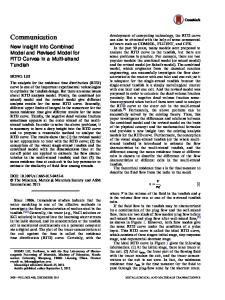Microbubble Swarms in a Full-Scale Water Model Tundish
- PDF / 1,575,580 Bytes
- 12 Pages / 593.972 x 792 pts Page_size
- 80 Downloads / 341 Views
ON
FOR enhancing liquid steel quality, the tundish, a vessel which used to be regarded essentially as a buffer and distributor of liquid steel between a ladle and the molds, plays a key role in cleaning liquid steel of a high proportion of inclusions prior to casting. These non-metallic inclusions,[1] including both endogenous and exogenous species, can seriously impact the steel’s mechanical properties, such as plasticity, toughness, and the fatigue limits of steel parts. A ‘‘clean steel’’ signifies that the non-metallic inclusions content must be limited to a ‘‘low level,’’ in two aspects: the quantity and the sizes of residual inclusions. Generally, the ability of a tundish to remove inclusions can be evaluated based on residence time distributions (RTD). Sahai and Emi[2] have outlined a correct way of using a combined model in analyzing RTD curves. Chen et al.[3] investigated the tracer mixing during RTD measurements in a single strand tundish. A numerical model was developed to simulate tracer diffusion concentration fields. These showed good SHENG CHANG, Ph.D. Student, is with the School of Materials and Metallurgy, Northeastern University, Shenyang 110004, P.R. China, and also with the McGill Metals Processing Centre, McGill University, Montreal H3A 2B2, QC, Canada. XIANGKUN CAO, Master Student, and MIHAIELA ISAC and RODERICK I.L. GUTHRIE, Professors, are with the McGill Metals Processing Centre, McGill University. Contact e-mail: roderick.guthrie@ mcgill.ca. ZONGSHU ZOU, Professor, is with the School of Materials and Metallurgy, Northeastern University. Manuscript submitted August 27, 2015. Article published online August 9, 2016. 2732—VOLUME 47B, OCTOBER 2016
agreement with their experimental data. In order to promote inclusion flotation in tundishes, extensive research has focused on reducing dead regions of flow, and increasing mean residence times. This has been achieved through optimizing the tundish configuration[4] using different kinds of flow modifiers. Jha et al.[5] carried out numerical modeling to study inclusion removal in a six-strand tundish, fitted with dams of different heights, located at different positions. They mentioned that the inclusion removal tendency increases with increasing dam heights, provided the dam was at ‘‘an appropriate position.’’ Morales et al.[6] and Cwudzinski[7] both reported that the combination of a turbulent inhibitor and dams can effectively increase the mean residence time of liquid in a tundish. Morales-Higa et al.[8] studied the use of a dissipative ladle shroud (DLS) in a four strand tundish. According to their results, the downward kinetic energy and entry flow velocity can be radically reduced using a DLS, owing to flow resistance generated by its convergent–divergent interior boundaries. Nonetheless, the buoyancy forces acting on the inclusions smaller than 50 lm are not enough for them to float up and reach the slag layer by Stokes flow,[9] so they cannot be readily removed using the conventional flow control devices. Rather they follow the flow of liquid steel. While submer
Data Loading...











